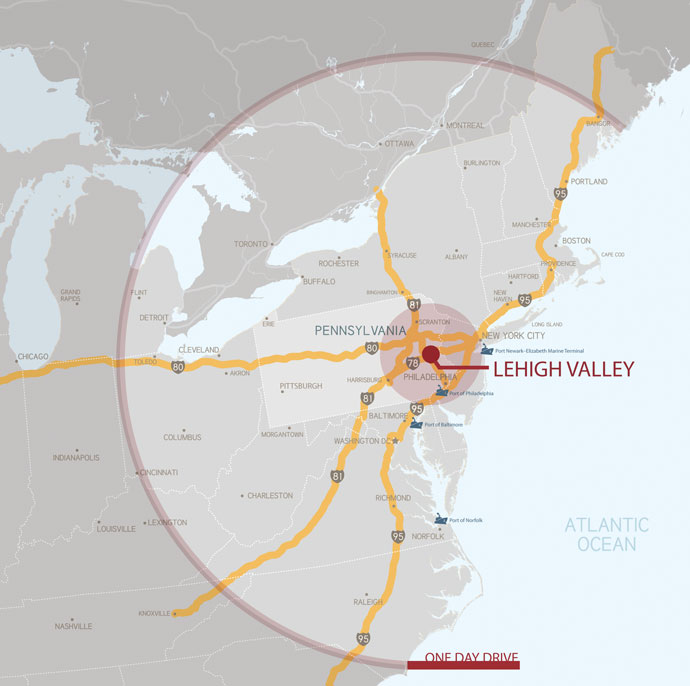The ratio of assets to challenges is one of the strongest positive ratios we have conducted and analyzed over the last 11 years.” That’s how Atlanta-based Garner Economics LLC characterized the Lehigh Valley’s strengths in a 2014 study commissioned by Lehigh Valley Economic Development (LVEDC). And Garner Economics produces lots of these studies.
Start with its eastern Pennsylvania location just north of the Philadelphia metro and just west of New York City and New Jersey. Not only is the Lehigh Valley in close proximity to numerous northeastern population centers. It’s also near key East Coast seaports and international airports, making transit of goods and people in and out of the region easy. Abundant rail service, rivers and interstate highways complete the transportation and logistics picture.
That might explain why Walmart is hiring nearly 1,000 people in the Lehigh Valley over the next few years to staff not one, but two new e-commerce fulfillment centers, the latest of which, a 1.2-million-sq.-ft. facility in Bethlehem, opened in July.
“This Bethlehem facility is part of a dense, multi-faceted network that combines new buildings, existing fulfillment assets, and our portfolio of stores to create thousands of points of distribution,” said Neil Ashe, chief executive officer, Walmart Global e-Commerce. “All of these elements working together enhance our ability to get more products to customers faster, at a lower cost, and provide more choices for shoppers.”
A Great Niche
Garner Economics cites four labor assets inherent to the Lehigh Valley: cost of labor, availability of post-secondary vocational training, quick access to higher education institutions and availability of engineering programs. These are not new assets to the region. They have served business and industry well for many years — 115 in the case of Crayola, which has had operations in the Lehigh Valley since 1900 (known as Binney & Smith in the early days). Corporate headquarters has been in Easton since 1976.
Today, the maker of crayons, markers, paints and activity kits operates in four Lehigh Valley facilities — two each in Easton and Bethlehem, making 3 billion crayons and 500 million markers annually. One of the facilities also makes Silly Putty.

“You’d be surprised at the sophistication of what’s involved in manufacturing formulations like these that are safe for children and have the color and benefits that our products have,” says Pete Ruggiero, executive vice president of global operations. “We’ve found a great niche, a lot of very capable chemical engineers and manufacturing employees who make that a reality every day.”
That needs to be the case going forward, too, notes Ruggiero, particularly as more companies bring operations back to the US from overseas, adding demand for technically skilled workers to an already thin supply. Crayola employs about 1,000 in the Valley and hires approximately 50 new manufacturing employees annually. LVEDC works closely with the company and many others in the region to identify ways to meet current and future workforce requirements.
“As we’re putting more and more automated equipment into our plants and existing mechanics and technicians retire, and as other businesses come into the area, there is an increasing demand for those workers,” says Ruggiero.
An Educated Assessment
“Lehigh Valley has a very hard-working and loyal workforce,” says Ruggiero, who says he can find the manufacturing skills in more than enough supply to meet Crayola’s demand year to year. A local staffing service supplies the workers, most of whom want to work full-time for the company once they have spent some time there. They consider becoming a full-time employee at Crayola to be “a great benefit,” says Ruggiero, who has worked at the company 18 years.
That’s long enough to offer an educated assessment of doing business in eastern Pennsylvania and in the Lehigh Valley, specifically: “The business climate here is very positive. There is a great partnership with local, county and state governments. We have enough challenges running a business, so government being a partner with us is very helpful. The nature of the workforce here — the skilled workers — makes the difference, and not just the hourly workers. Our ability to recruit engineers out of Lehigh University, Lafayette College and other universities locally is a real enabler to us. As we’ve automated our factories and done continuous improvement initiatives, we have needed to bring talent into our operations area. We’ve had no trouble finding great people here.”
The region’s logistics assets — roads, ports, rail, warehousing and expert third-party logistics providers — facilitate Crayola’s import and export businesses and “have brought great advantage to our business,” Ruggiero asserts. All those benefits aside, he adds, “it’s a great place for employees to live. Our people are happy, which is partly our culture at the company. But it’s also the local culture in which they live.”
This Investment Profile was prepared under the auspices of Lehigh Valley Economic Development. For more information, contact LVEDC at (610) 266-6775, or visit www.lehighvalley.org.

